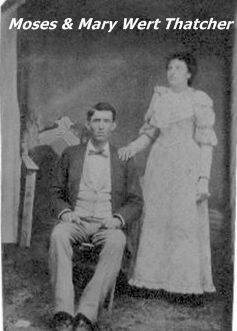
Mary Wert Thatcher
Mary was born November 10, 1807 in New Jersey to Nancy Slater and Godfrey Wert per Ancestry.com. Her mother passed away in 1810 and the father must have remarried as there is recordings of half brothers and half sisters. Actually 12 siblings!
Mary married Moses Thatcher in 1831 when she was 24 years old. Her first son, George was born in New Jersey as well as son Nathaniel and Godfrey. Son Elijah was born in New York and another son Moses also in New York and daughter Mary Ann. Loraine was the first daughter born in Darke County in 1846. Other births include, Sara Elizabeth, Charlotte, and John which was the last birth in 1854 when Mary was 47 years old. The Thatcher’s settled in Twin Township in 1844 near Ithaca, Ohio.
Thru Find-A-Grave, we find the following Thatcher marriages: George married to Louisa Colville; Nathaniel to Lydia Ellen Smith; Elijah never married; Moses Jr. died soon after the war. He served from 1862-1865 with Co. B 110 Regiment OH Volunteer Infantry.
Daughter Mary Thatcher was the wife of John Warwick and Charlotte Thatcher married Jasper Todd. We are not sure about Loraine or Sarah E. Thatcher and John only lived a month after being born. We need to research Godfrey info as we have two different dates. One says he died at 2 yrs. old and another in 1889.
Mary passed on November 30, 1878 and is buried here at 71 years in Ithaca Cemetery with husband Moses.
It is recorded that Peter Wert who lived down the hill before you come into Ithaca, was Mary’s brother. Peter and son, Watson Wert ran the mill there and across the road was the tannery.
According to Family Search, Annette Stewart who portrayed Mary Wert Thatcher, is a cousin 5 times removed through the Willard, Poe, Baker and Sease lines.
In our story for the cemetery program, our Mary is the local herb healer who made salves, tonics and used her herbs and healing knowledge to “doctor” the sick and injured as there was no local doctors we find record of until Dr. Matchett came in the 1850’s. And there was early doctors in Arcanum if people could afford them.
The herb garden was grown for not only cooking but medicinal use as well as herbs, plants, nuts, flowers, and veggies used to make dye for their yarn and linens.
A lot of early settlers got the chills and fever when we first came here. Found it was malaria from the sqitters. (mosquitoes). They like this swampy ground around here. We’re working on trying to get it drained. That will help. Boneset helps the fever.
Now if they get a chest cold Mary’s advise is “to grease them up real good with goose grease and a mustard plaster to help break that cough up. Sometimes we put a mess of cooked onions on their chest as a poultice too. Of course we put a layer of flannel down.” Another good use for onions besides flavoring for cooking is the skins which make an excellent dye for our wool and linens for weaving. We also use those black walnut hulls for a dye for a nice brown color and other herbs with beautiful colors to help dye yarn and linen. Goldenrod sure makes a beautiful gold color.
In these days, families helped each other with cabin raisings, quilting, preparing food for winter, butchering and then we had good times with barn dances and later meet’en at the old school house for plays, church, ciphering matches and spell’en bees. Making apple butter from our apple orchard was a big family affair. Took all day stir’in it to get just right and than putting in the crocks for winter. Best thing you ever tasted this side of southern Darke County. This is Mary’s story:

Summer time is real busy around here. Besides eat’en from our gardens all kinds of vegetables we put up food for the winter. We do a lot of pickling of peppers and cucumbers. Another method is drying. Apples, pumpkin, pears, grapes work best. We eat a lot of beans too. String them up to dry and call them leather britches. Real good eat’in.
Now Moses he made me the best root cellar. We use those to store our root vegetables during the cold months. That way we can have beets, carrots, potatoes, turnips and onions during the winter.
Soon we’ll be gathering huge heads of cabbage to make slaw for meals and shred, mix with salt and leave to ferminate in huge crocks and have the best sauerkraut. Fall time were busy harvesting the last of the beans, root vegetables, apples, sweet potatoes, pumpkins and pop corn. Over yonder in Monroe Twp. I heard they grow indian corn and grind it to make flour.
Oh the flour mills are another thing. The Wert’s had a mill to grind wheat or corn. When the water was down too low and the mill wasn’t operating, we would head down to Lewisburg or up to Bears Mill. Often our boys would take the grain to the mill and return with a fine sack of flour.
Well better move on. I see John coming and I can pass this comfrey on to him for his dear wife Dicey to make a compress for him. And got to get around to gather some horseradish root to make horseradish for all our pork dishes. Plus a big tablespoon of that will help break up sinus congestion. Think Moses might be coming down with an annoying summer cold. I’m gonna kill a chicken, gather some carrots and onion, and make a big ole pot of chicken dumpling soup. That bone broth will help him feel better in no time. Thank you for visiting today!
Please read and follow AWTHS blog guidelines concerning copyrights, contents and photos.
